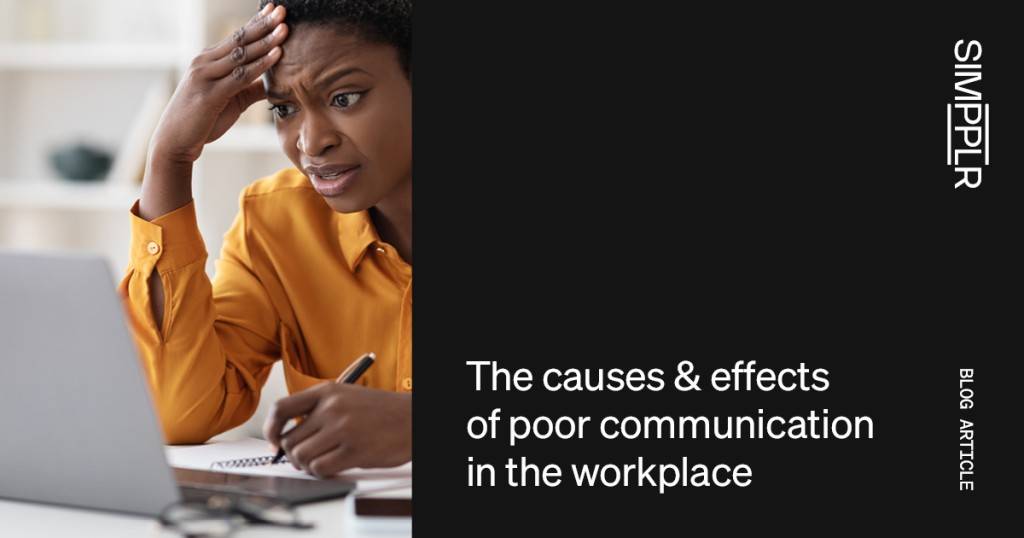Every leader communicates — but not every leader communicates well. How you speak, listen, and respond shapes your influence, your team’s culture, and your organization’s outcomes. Yet, few leaders receive formal training on the communication styles that drive clarity, connection, and trust. Instead, they fall back on habits — some helpful, some harmful.

Types of communication styles leaders should know about
- 1 What is a communication style?
- 2 Why are communication styles important?
- 3 How to identify your communication style type
- 4 Leadership communication styles in the workplace
- 5 What are the different communication style types?
- 6 Communication styles in team dynamics
- 7 Managing communication styles in remote and hybrid teams
- 8 How to develop a flexible approach to communication styles
- 9 Choosing the most effective communication style for each situation
- 10 Tips to improve your communication style
- 11 How Simpplr supports effective leadership communication
These leadership communication styles aren’t hardwired traits but learned behaviors absorbed from our environments and reinforced over time. The good news? They can be identified, adjusted, and improved with practice. Whether you’re leading a project, a department, or an entire organization, understanding different communication styles — especially how they manifest in leadership — can make the difference between team dysfunction and cohesion.
This guide breaks down the most common communication style types, with insights on how to recognize them, examples of how they show up at work, and tips for working with people who lean into each style.
What is a communication style?

A communication style is a person’s overall approach to exchanging information. It includes how we use tone, body language, facial expressions, formality, word choice, and even how we listen. These verbal and nonverbal habits influence how we express ourselves, connect with others, and are perceived in return.
We often assume communication style is a fixed part of someone’s personality — as if being aggressive or passive is just who they are. But that’s not quite true. These styles are learned patterns that can shift over time. That’s why understanding communication style types matters, especially in a team setting. Styles can either support collaboration or quietly break it down — which is why understanding these patterns is crucial for effective leadership.
Why are communication styles important?
Picture a five-person team. One person is assertive. Another communicates aggressively. The third avoids confrontation by going silent. The fourth masks discomfort with sarcasm. The fifth is triggered by sarcasm and begins subtly undermining others. Suddenly, you have a team in conflict — rooted almost entirely in communication style mismatches.
Often when we say we don’t get along with someone, it’s not their personality that’s hard to work with — it’s their communication style.
Different people favor different styles. Understanding and adapting to those differences is key to building trust, resolving conflict, and leading effectively — at work and beyond. It’s also foundational to empathy. Recognizing someone else’s style gives us the chance to meet them halfway and build stronger connections. But first, you need to understand your own default patterns.
How to identify your communication style type
Before you can improve the way you communicate with others, you need to understand the patterns you rely on today. Most people don’t give much thought to their communication style — especially when things are running smoothly. But under pressure, your default tendencies come out. That’s when misunderstandings happen. Getting clear on how you communicate in different situations is a powerful first step toward more effective leadership.
Here are a few ways to identify your communication style:
- Reflect on how you respond in different situations. Are you direct or indirect? Cooperative or dominating?
- Pay attention to feedback you’ve received. If multiple people say you interrupt or avoid conflict, it may signal patterns.
- Take a communication style quiz. These are simple assessments that highlight your default tendencies.
- Talk to a coach or attend a training session. A pro can help you spot both strengths and blind spots.

Leadership communication styles in the workplace
Leadership communication styles shape team culture and impact everything from morale and productivity to trust and cohesion. The most effective leaders recognize their own communication tendencies and adjust based on the audience and situation. Some leaders flex between multiple communication style types — coaching direct reports with empathy while addressing companywide issues with clarity and confidence.
The ability to adapt your communication builds credibility and influence. Whether you’re managing projects, giving feedback, or presenting to senior stakeholders, understanding how different communication approaches land with others is essential for leadership effectiveness. Let’s examine each style in detail.
What are the different communication style types?

There are five basic communication styles that appear in workplace settings. While these aren’t permanent personality traits, people tend to default to specific styles — especially under stress. Understanding these patterns helps you adjust your approach, resolve conflicts, and build stronger professional relationships.
1. Assertive communication
Assertive communicators speak clearly and respectfully. They advocate for themselves while also considering others. They tend to be confident, consistent, and open to feedback.
How to recognize it:
- Calm, steady voice
- Even pace and appropriate emotion
- Relaxed, open posture
How they make others feel:
- Safe to speak up
- Heard and respected
- Calm and clear
When to use it: In most professional situations. Research shows assertive communication styles create psychological safety in teams.
How to use it: Assertive communicators set boundaries without hostility. They’re direct but empathetic.
Example: “I wish I could, but I don’t have time today. If we can reschedule my 3:00 meeting, I can meet then.”
How to respond: Match the tone. Assertiveness tends to be contagious in a good way. The more people communicate this way, the more likely others will follow.
2. Aggressive communication
Aggressive communicators push their ideas forcefully, often ignoring the thoughts and feelings of others. They may speak loudly or interrupt and can create tension or fear.
How to recognize it:
- Raised voice and fast speech
- Hostile or angry tone
- Body language that feels confrontational
How they make others feel:
- Defensive
- Intimidated
- Disrespected
When to use it: Rarely. Only in true emergencies, like safety issues, where immediate compliance is critical.
How to handle it: Stay calm and assertive. Don’t match the aggression, and don’t retreat. Acknowledge the emotion and steer the conversation back to specifics.
Example: “I can tell you’re frustrated. What are you concerned about specifically?”
How to respond: Lead with curiosity and empathy. You may need to redirect the conversation more than once to get things back on track.
3. Passive communication
Passive communicators avoid conflict and often say what they think others want to hear. They may hesitate to set boundaries or express disagreement, which can lead to misunderstandings.
How to recognize it:
- Quiet tone
- Apologetic language
- Avoids eye contact or shrinks body posture
How they make others feel:
- Overconfident (short-term)
- Frustrated (long-term)
- Burdened by uneven workload
When to use it: In high-tension situations where defusing conflict is more important than resolving it right away, but avoid relying on this style.
How to handle it: Encourage them to speak up. Create space for their input, and reinforce that it’s safe to share.
Example: “Thanks for volunteering, but let’s pause and look at everyone’s current workload first.”
How to respond: Be supportive, not dismissive. Over time, you’ll help them build the confidence to communicate more assertively.
4. Passive-aggressive communication
Passive-aggressive communicators express frustration indirectly. Instead of speaking up, they may use sarcasm, gossip, or back-channel complaints.
How to recognize it:
- Sarcastic comments
- Mixed messages (friendly words, tense tone)
- Complains behind closed doors
How they make others feel:
- Unsettled
- Confused
- Attacked
When to use it: You shouldn’t. It creates mistrust and breaks down relationships.
How to handle it: Address the real issue directly and invite them to do the same.
Example: “I hear your concern. Let’s talk about how the new tools might impact our current workload.”
How to respond: Model directness. Keep the door open for honest discussion without judgment.
5. Manipulative communication
Manipulative communicators use guilt, flattery, or deception to get what they want. They may shift stories or act differently depending on who’s present.
How to recognize it:
- Inconsistent stories
- Exaggerated reactions
- Denies previous behavior
How they make others feel:
- Cautious
- Frustrated
- Angry
When to use it: It’s not a healthy style. While it may be effective short-term, it damages trust.
How to handle it: Be direct. Put agreements in writing and hold firm boundaries.
Example: “We need to work together on this. Let’s schedule time to meet and get it done.”
How to respond: Stay calm. Document conversations. Keep communication clear and factual.
While these communication styles appear as distinct categories, most people exhibit a blend of approaches depending on context, relationship, and stress levels. The key is recognizing which patterns dominate your team’s interactions.

Communication styles in team dynamics
Great teamwork depends on how well people understand each other — and communication styles play a huge role in that. Teams that prioritize a clear, respectful exchange of ideas typically demonstrate stronger collaboration and results. Teams that primarily use assertive communication styles typically show higher productivity and collaboration levels. When other communication style types dominate — particularly passive, aggressive, or manipulative approaches —trust issues often emerge.
The key is awareness. Leaders who understand the different communication style types can better guide their teams, defuse tension, and encourage healthier interactions. These team dynamics become even more complex in today’s increasingly distributed work environments.
Managing communication styles in remote and hybrid teams

Remote and hybrid work environments change how communication styles function and are perceived. Without body language and real-time feedback, leaders must communicate with greater precision and purpose.
The communication styles discussed earlier manifest differently online — aggressive communicators often dominate digital channels, while those with passive communication style types may become virtually invisible. Add time zones and delayed responses, and small issues can quickly snowball.
Employee experience platforms like Simpplr ensure everyone — whether in the office, at home, or on the go — receives the same personalized updates, communications, and resources through a unified intranet experience.
To keep communication inclusive and productive across distributed teams, leaders should take a structured approach. In virtual meetings, set ground rules that prevent one person from taking over and give space to quieter team members. Rotate facilitation roles to build diverse communication strengths across the team.
Asynchronous communication also needs clarity. Set norms for what belongs in chat, email, or shared docs. Keep a record of team members’ preferences and cultural communication styles — what feels direct in one culture may feel confrontational in another. Whether in office settings or across digital channels, the most effective communicators share one critical skill: adaptability.

How to develop a flexible approach to communication styles
No one style works perfectly in every situation. Effective communicators — and especially effective leaders — know how to adapt. Flexibility in your communication style allows you to meet people where they are, defuse potential conflict, and influence without dominating. It also models the kind of emotional intelligence that builds trust across teams.
While assertive communication is your best bet in most situations, it’s important to recognize that not everyone responds to the same approach. Different people, personalities, and situations call for different styles. The ability to assess a conversation in real time and pivot when needed is what sets great communicators apart.
You can learn to shift your communication style as needed:
- Aggressive people may need calm, firm boundaries
- Passive communicators need reassurance
- Manipulative communicators need consistency and accountability
Becoming more adaptable in your communication style takes time, experimentation, and reflection. But the payoff is meaningful: stronger relationships, smoother collaboration, and a greater ability to lead with empathy and impact.
Choosing the most effective communication style for each situation
While balanced, direct communication often proves most effective, the reality is that different situations call for strategic adaptations in your communication approach. The most successful leaders develop a decision-making framework that helps them navigate this complexity with intention rather than defaulting to habit.
Consider evaluating each communication scenario along two critical dimensions: urgency and relationship sensitivity.
High-urgency situations with low relationship sensitivity (like safety emergencies) may require temporarily shifting toward a more directive, even aggressive style to ensure immediate action. Conversely, sensitive relationship-building moments with team members benefit from a more collaborative, patient approach that creates psychological safety.
Real workplace scenarios illuminate how this works in practice. When announcing an unexpected organizational restructuring, leaders need to balance clear, assertive messaging about the changes with empathetic awareness of emotional impacts. During innovation workshops, creating space for quieter voices may require deliberately moderating more dominant communicators while actively drawing out passive participants.
Consider this situational matrix:
High urgency / low sensitivity
Use direct, concise communication focused on immediate action steps. Example: “We need to fix this customer issue immediately. John, please contact the client while Ana resolves the technical problem.”
High urgency / high sensitivity
Maintain directness but add acknowledgment of impact. Example: “We need to rework this entire presentation before tomorrow. I know this means extra hours, and I appreciate your commitment. Let’s divide sections now.”
Low urgency / low sensitivity
Fully assertive communication works well here. Example: “Over the next quarter, I’d like us to improve our documentation process. What approaches have worked well for everyone?”
Low urgency / high sensitivity
Use a more collaborative, coaching-oriented style. Example: “I’ve noticed some patterns in your recent work that I think we could explore together. When would be a good time to discuss some development opportunities?”
The most effective leadership communication styles aren’t static — they’re responsive. By consciously selecting your approach based on specific needs, you demonstrate true communication fluency that builds trust and drives results in any situation.
Building communication flexibility requires practice, but the results are worth it. When you can adjust with intention — not just habit — you create more room for understanding, collaboration, and authentic connection.

Tips to improve your communication style
Improving your communication style doesn’t mean changing who you are — it means being more intentional with how you engage, express ideas, and respond to others. Small shifts in tone, word choice, and body language can go a long way toward building trust and clarity in your relationships.
Think of communication as a skill you develop, not a trait you either have or don’t. Just like learning to play an instrument or speak a new language, it gets easier with practice.
These tips will help you fine-tune your communication over time:
Listen actively
Be fully present in the conversation. That means setting aside distractions, making eye contact, nodding, and asking questions that reflect genuine interest. Don’t just wait for your turn to speak — listen to understand. Reflecting back what you heard can go a long way toward building mutual respect.
Be honest
Honesty builds trust, but it’s most effective when paired with kindness. Think about the intention behind your words. Are you offering helpful feedback or just trying to be right? Honest feedback, when offered with care, makes teams stronger and more resilient.
Build confidence
You don’t need to be loud to be confident. Start with small changes, like setting a boundary or making a suggestion in a meeting. Confidence grows with repetition and with the courage to speak even when your voice shakes.
Keep practicing
No one becomes an expert overnight. Pay attention to how your communication lands with others, and adjust as you go. If you slip into old habits, don’t be hard on yourself. Just keep practicing. Every conversation is a chance to get better.
How Simpplr supports effective leadership communication
Individual communication skills are only part of the equation — organizations need systems that reinforce clear messaging across all levels. Modern employee experience platforms like Simpplr provide the infrastructure that helps scale effective communication practices throughout an organization.
Whether you’re demonstrating assertive leadership, amplifying quieter voices, or addressing communication breakdowns, the platform connects your workplace tools and workflows to support consistent messaging at every level of your organization. AI-driven analytics show which messages resonate with employees, while surveys and sentiment analysis provide concrete feedback on effectiveness.
With Simpplr as your communication foundation, you can apply insights about various communication styles, recognize your default approaches, and practice the flexibility needed to enhance your leadership effectiveness. Whether you’re working with in-person teams or managing across digital boundaries, the right platform transforms differing communication styles from a leadership challenge into an organizational strength.
Ready to find out how Simpplr can help you improve employee communication? Request a demo today.

Watch a 5-minute demo
See how the Simpplr employee experience platform connects, engages and empowers your workforce.
- #1 Leader in the Gartner Magic Quadrant™
- 90%+ Employee adoption rate















